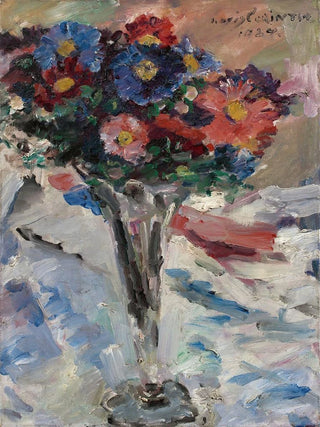Art print | Asters in a goblet - Lovis Corinth


View from behind

Frame (optional)
"Asters dans un verre calice" by Lovis Corinth evokes ephemeral beauty, capturing the very essence of nature through the delicacy of flowers. In this painting, the asters, symbols of love and wisdom, stand with timeless elegance, offering a poetic vision of a moment frozen in time. The soft light passing through the art print highlights the vibrant nuances of the petals, creating harmony between the fragility of the flowers and the solidity of the container. This piece, both simple and complex, invites the viewer to immerse themselves in a universe where nature and art meet, revealing an emotional depth that transcends mere decoration.
Style and uniqueness of the artwork
Lovis Corinth's style is characterized by an impressionist approach, blending bold color strokes with fluid forms. In "Asters dans un verre calice," he manages to create an intimate atmosphere through a subtle palette where gentle hues intertwine with luminous flashes. The composition, although centered on the vase and its flowers, extends beyond the boundaries of the canvas, inviting the eye to explore the delicate details of the asters. The brushstrokes, both vigorous and delicate, demonstrate the artist's technical mastery while infusing the canvas with an almost palpable vitality. Each petal seems to vibrate under the effect of light, and the glass, with its reflections, acts like a prism, transforming the scene into a dance of colors and shapes.
The artist and his influence
Lovis Corinth, a major figure of the German artistic movement, established himself through his unique style and his ability to capture the essence of his subjects. Born in 1858, he evolved in a rapidly changing artistic context, between realism and impressionism. His work reflects a constant quest for truth and emotion, aiming to depict not only the appearance of things but also their soul. Corinth influenced many contemporary artists, and his legacy endures in the modern art world. His ability to marry technique with emotion, as demonstrated

Matte finish

View from behind

Frame (optional)
"Asters dans un verre calice" by Lovis Corinth evokes ephemeral beauty, capturing the very essence of nature through the delicacy of flowers. In this painting, the asters, symbols of love and wisdom, stand with timeless elegance, offering a poetic vision of a moment frozen in time. The soft light passing through the art print highlights the vibrant nuances of the petals, creating harmony between the fragility of the flowers and the solidity of the container. This piece, both simple and complex, invites the viewer to immerse themselves in a universe where nature and art meet, revealing an emotional depth that transcends mere decoration.
Style and uniqueness of the artwork
Lovis Corinth's style is characterized by an impressionist approach, blending bold color strokes with fluid forms. In "Asters dans un verre calice," he manages to create an intimate atmosphere through a subtle palette where gentle hues intertwine with luminous flashes. The composition, although centered on the vase and its flowers, extends beyond the boundaries of the canvas, inviting the eye to explore the delicate details of the asters. The brushstrokes, both vigorous and delicate, demonstrate the artist's technical mastery while infusing the canvas with an almost palpable vitality. Each petal seems to vibrate under the effect of light, and the glass, with its reflections, acts like a prism, transforming the scene into a dance of colors and shapes.
The artist and his influence
Lovis Corinth, a major figure of the German artistic movement, established himself through his unique style and his ability to capture the essence of his subjects. Born in 1858, he evolved in a rapidly changing artistic context, between realism and impressionism. His work reflects a constant quest for truth and emotion, aiming to depict not only the appearance of things but also their soul. Corinth influenced many contemporary artists, and his legacy endures in the modern art world. His ability to marry technique with emotion, as demonstrated






